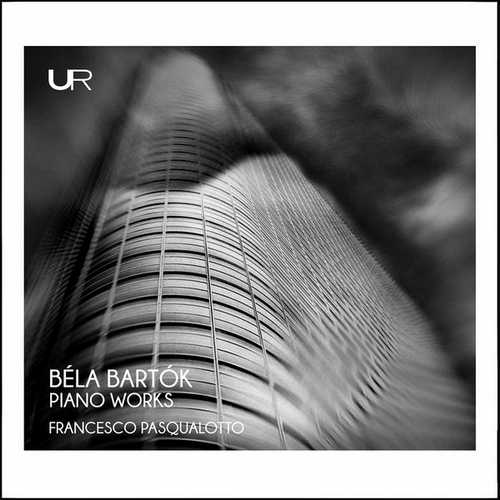
Composer: Béla Bartók
Performer: Francesco Pasqualotto
Format: FLAC (tracks)
Label: Leonardo
Catalogue: LDV14074
Release: 2021
Size: 198 MB
Recovery: +3%
Scan: cover
Out of Doors, Sz. 81, BB89
01. I. With Drums and Pipes
02. II. Barcarolla
03. III. Musettes
04. IV. The Night’s Music
05. V. The Chase
4 Dirges, Op. 9a, 4 Dirges, Sz. 45
06. I. Adagio
07. II. Andante
08. III. Poco lento
09. IV. Assai andante
Piano Suite, BB 70, Sz. 62, Op. 14
10. I. Allegretto
11. II. Scherzo
12. III. Allegro molto
13. IV. Sostenuto
10 Easy Pieces, Sz. 39
14. Dedication
15. No. 1, Peasant Song
16. No. 2, Frustration
17. No. 3, Slovakian Boys’ Dance
18. No. 4, Sostenuto
19. No. 5, Evening in Transylvania
20. No. 6, Hungarian Folk Song
21. No. 7, Dawn
22. No. 8, Slovakian Folksong
23. No. 9, Five-Finger Exercise
24. No. 8, Bear Dance
14 Bagatelles, BB 50, Sz. 38
25. No. 1, Molto sostenuto
26. No. 2, Allegro giocoso
27. No. 3, Andante
28. No. 4, Grave
29. No. 5, Vivo
30. No. 6, Lento
31. No. 7, Allegretto molto capriccioso
32. No. 8, Andante sostenuto
33. No. 9, Allegretto grazioso
34. No. 10, Allegro
35. No. 11, Allegretto molto rubato
36. No. 12, Rubato
37. No. 13, Lento funebre
38. No. 14, Waltz
Given Bartók’s expressive variety it would be not excessive to say that his tormented works represents the keystone of the entire 20th century. A technical complexity joins a very varied musical language which often bear a strong influence from the popular music as well as from Liszt and Debussy and the ornamentation of Couperin. Bartók could be defined as a man of a thousand faces and with this album some-ones are tried to be revealed.
Francesco Pasqualotto (1982) lives in Gallarate, where he has graduated from Liceo Classico in 2001. He studied piano under the direction of Maestro Maria Grazia Bellocchio. In 2004 he graduated with honors at Conservatorio Verdi in Milano, where he was admitted as private student. He attended the experimental composition course given by Maestro Sandro Gorli at the same Conservatoire. He has graduated in Bergamo in second level degree with high votes. He has attended master classes that have allowed him to be exposed to teachers and concert artist of international fame like Maestro Franco Scala, Bruno Canino, Louis Lortie, Filippo Gamba, Paolo Bordoni, Konstantin Bogino, Pier Narciso Masi, Trio Altenberg, Emilia Fadini.
Given the many facets of his work, perhaps it is not too much to say that Bartok’s tormented work represents the keystone of the entire twentieth century.
Bartok’s first piano works of some importance are strongly influenced by Lisztian writing (for example the Rhapsody op.1) and language, but already the 14 Bagatellas (1908) have a more dry writing. These are songs, greeted with enthusiasm by Busoni, which present a very heterogeneous language, both for technical complexity (the former, for simplicity, would even seem to be designed as songs for beginners, while no 10 and no 14 are decidedly more difficult ), both as a language. The Ten Easy Pieces were composed in the same year and somehow deepen the theme of “beginner songs” already present in the Bagatelle. The piece opens with a mysterious musical dedication, supernumerary compared to the ten pieces, in which we hear, clear and clear, again the theme-motto Stefi Geyer. The first pieces are extremely simple, yet they always have a color, an expression, a language of such interest as to make them absolutely effective even as concert pieces. As in the Bagatelle op. 14, a characteristic sign is the variety of language. There are passages with a clear popular flavour (nos 1, 2, 3, the splendid 5 that Bartok recorded several times, the 6 and 8). Others have a more experimental language. Shortly afterwards the 4 Diriges op. 9 (1910), unfortunately and incomprehensibly of rare execution. The influence of C. Debussy is immediately felt in the first one, whose music had thrilled the Hungarian composer at that time.